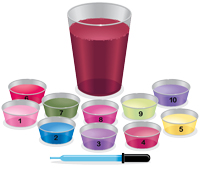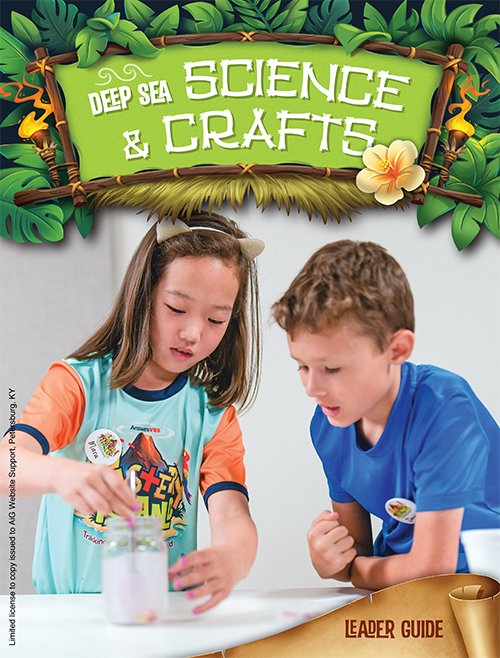Mystery Color
Day One Experiment
on November 22, 2021; last updated November 30, 2021Materials (for up to 10 students)

Note: It’s great to test all 10 of the acids and bases on this list (the acids and bases start part way down the list with the 7-Up® and go through the water), but it’s also fine to choose fewer if need be. The experiment still works; it just has fewer acids and bases to test.
- 1/8 head of red cabbage, chopped
- Large stock pot
- Boiling water
- 1 coffee filter
- 1 funnel
- Storage container
- 10 1-oz. condiment cups with lids or plastic test tubes with lids (see Tip Corner)
- 10 pipettes/droppers (these can be shared and reused)
- 1 t. 7-Up®
- 1 white antacid tablet
- 1 t. seltzer water
- 1 t. white vinegar
- 1 t. washing soda
- 1 t. lemon juice
- 1 t. baking soda
- 1 t. cream of tartar
- 1 t. milk of magnesia
- 1 t. water
- Plastic spoons
- Clear plastic cup
- Red Cabbage pH Indicator Chart
Pre-Prep
Boil chopped red cabbage until the water reaches a deep purple color. To do so, cut the cabbage into wedges, then put in a large stock pot that is half full of water. Bring the water to a boil and reduce the heat to medium. Boil the cabbage for about an hour, uncovered, until it is fork tender. Place a coffee filter in the top of a funnel and pour the cabbage water through the funnel. Store the filtered cabbage water in a storage container in the refrigerator. This can be done several days ahead of time.
The day of, fill the test tubes or condiment cups with the various acids and bases listed above and label them 1–10, with one being the 7-Up®, two being the white antacid tablet, etc. Do not put the actual names of the items but only the numbers, because the goal is for the kids to figure out the mystery of what is in their cups.
The dry ingredients (antacid tablet, baking soda, washing soda, cream of tartar) should have one teaspoon dissolved in water.
Put a set of 10 condiment cups or test tubes, each with a different acid or base, on the table. Place a jar of cabbage water in the middle of the table along with 5–10 droppers/pipettes. One way to divide up is to have 10 kids work at a table so they each get a different acid or base to test, but if you have fewer kids per table, they will just work together to test all 10.
Note: For demonstration purposes, prepare one set of condiment cups or test tubes that is labeled with the name (not the number) of what is inside. Keep this up front so the kids can match the color in their cups to the demo cups at the end of the experiment.
Teaching Tie-In
Here in our science lab today, we have a mystery to solve. You each have a sample of a different substance, but you need to figure out what kind of substance it is. This mystery is solvable, but some things are beyond our ability to understand. When it comes to God, there are mysteries that are far too great for us to figure out, and that’s okay—things like how God could become a baby, or how God can be one God in three Persons. I’m really glad that God’s ways are sometimes beyond us, because if we could figure everything out about God, he wouldn’t be the great, beyond description God that he is, right? Pause for responses. But the cool thing is, God has given us many clues in his Word about who he is because he wants to have a relationship with us. We can know God! Now let’s get on with solving this mystery!
Class Time Directions
There are two main types of liquids in the cups in front of you. Some will be an acid and some will be a base. Acids and bases are all around us. For instance, how many of you like lemons or sour foods? Take responses. Have you ever sucked on a lemon? Take responses. Foods that are sour, like lemons, have acids in them. Your body uses acid in your stomach to help digest food. In fact, if you get too much acid in your stomach, you may have a tummy ache.
Bases are all around us, too. Have any of you washed your hands today? Take responses. If you did, the soap you used was probably a base, just like most cleaning products are.
So how can we tell if something is an acid or a base without tasting it—especially with things like soap that we can’t taste? Scientists use something called a pH scale to measure if something is an acid or a base. Little p, big H. Let’s get down low and whisper “p” then jump up and shout “H.” Do so.
There’s a pH scale with numbers that go from zero to 14. Show the Red Cabbage pH Indicator Chart. If a substance is tested and it gets less than seven, it’s an acid. The lower the number, the stronger the acid. For instance, there’s a strong acid in the battery that helps run your car, and it gets a one on the pH scale. A one is so acidic it wouldn’t be safe for humans to eat or even touch! If something gets exactly seven on the pH scale, that means it’s neutral, which means it’s not an acid or a base. Distilled water is an example of a neutral solution. If something on the pH scale is more than seven, it’s a base. Fourteen is the strongest base.
So now you get to do an experiment to see if the stuff in your cup is an acid, a base, or neutral. You’re going to take the dropper in front of you, fill it with some purple cabbage water that’s in the middle of the table, and then squeeze the cabbage water into the cup in front of you. Then match your color to the Red Cabbage pH Indicator Chart to figure out if you have an acid, a base, or a neutral.
Let’s see how well you did solving your mystery. How many of you had something that turned a reddish color? Take responses. Did you decide it was an acid? Take responses. How many had a purplish color? Take responses. Did you decide it was neutral? Take responses. How many of you had a greenish yellow color? Take responses. Did you decide it was a base? Take responses.
Now, let’s see if you can match your color to the labeled demo cup that has the same color. Then you’ll be able to figure out exactly what the liquid is in your cup! Do so. You may say something like the following.
Raise your hand if you had #2. Is it an acid or a base? Take answers. You had the antacid. Continue with the other numbers as you finish it out.
Tip Corner
- This experiment takes the most prep time of all the experiments, but it was a huge hit with the kids at the test churches.
- Make sure nobody tries to drink the washing soda. It is safe and nontoxic to touch, but not to ingest.
- One batch of cabbage juice will make enough for multiple groups.
- To make your set of demo cups easier to see, use 9-oz. clear plastic cups rather than condiment cups.
- It helps to keep the lids off the carbonated items because the carbonation causes them to pop off. Prep these close to the time and keep the lids off.
- Science terms introduced today are pH, acid, and base. If you have older students, you may also want to introduce the term anthocyanin. This is a blue, violet, or red pigment found in plants. The anthocyanin in the cabbage juice, which gives it the purple color, changes color based upon pH.
Related Downloads
Red Cabbage pH Indicator Chart
PDF DownloadMystery Island Deep Sea Science & Crafts
Kids love science experiments and crafts! This guide contains everything you need to coordinate the daily science experiments and crafts for all age groups.
Browse Kids Book- © 2024 Answers in Genesis
- Privacy Policy
- Contact
- About

